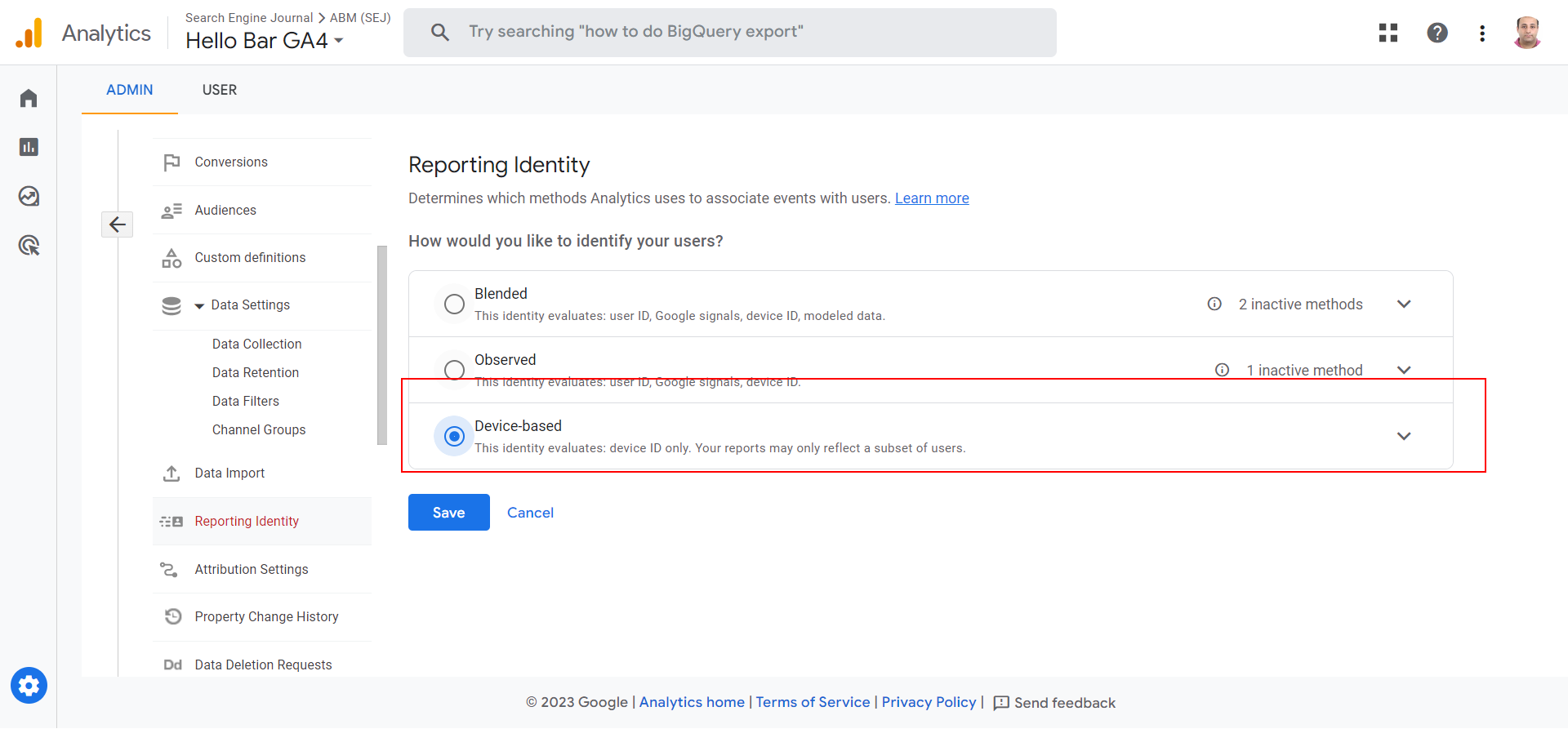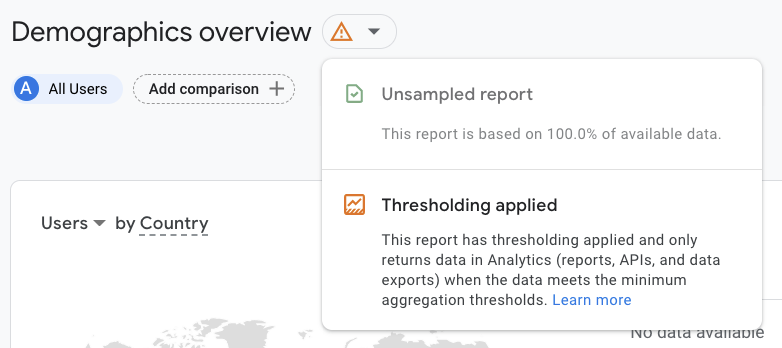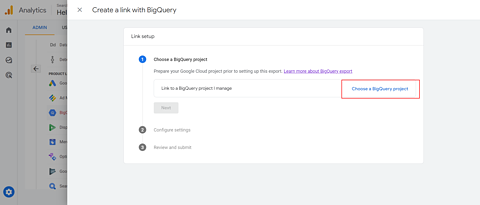SEO
7 Common Google Analytics 4 Configuration Mistakes To Avoid

If you had a chance to read previous guides we’ve published on Google Analytics 4 (GA4), you probably know that it is not a plug-and-play analytics tool like Universal Analytics was.
There is a lot of information one needs to absorb in order to be able to set up GA4 properly, and time is ticking.
-
Screenshot from Google, May 2023
With GA4 being a more complex tool, it’s easy to make mistakes that can hinder the accuracy and reliability of the data collected.
In this article, we will explore five common Google Analytics 4 mistakes that can easily happen and provide practical tips to avoid them.
1. Not Setting Data Retention Period
GA4 comes with a two-month data retention period by default, and you have the option to set it to 14 months. The retention period is applied to custom reports in explorations, whereas data in the standard reports never expire.
Once the retention period has passed, data will be automatically deleted – which means if you don’t change that setting as you set up GA4, you will not be able to run YoY custom reports and will lose valuable historical data.
In order to change the retention period, navigate to Data Settings > Date Retention, and in the dropdown, choose 14 months.
-
 Retention setting.
Retention setting.
You will also notice a checkbox reading “Reset user data on new activity,” which means the 14-month data retention period is counted from the moment of the user’s last visit onwards.
In other words, each time a user engages in a new activity, their data retention period gets extended for another 14 months.
Honestly, I can’t think of a use case when you would choose to turn that option off, so I keep it switched on.
2. Dimensions With High Cardinality
High-cardinality dimensions are dimensions that contain more than 500 unique values within a single day. This can present challenges and limitations in data analysis within GA4.
Cardinality in GA4 can negatively affect data accuracy and reliability.
For example, when you track the exact word count as a custom dimension on every article page, you may end up having high cardinality if you have thousands of articles because the word count can be different for every article.
How To Fix High Cardinality
To mitigate the impact of high cardinality in GA4, consider creating a bucket of values.
With the example above of word count custom dimension, it really doesn’t matter that much whether the article will have 500 or 501 words. You can bucket values into ranges like:
- <500.
- 500-1000.
- 1001-1500.
- 1501-2000.
- +2000.
And instead of pushing too many distinct values, you will have only five different dimensions.
Also, as a best practice, always define custom dimensions wisely.
Ensure that custom dimensions align with your analysis objectives and consider their potential impact on data accuracy and resource consumption.
3. Not Linking To BigQuery Account
Linking to BigQuery was available in Universal Analytics 360 but not in the free version. With GA4 now, all users have access to that premium feature.
Since it is exporting data to BigQuery from the moment you connect, it’s important to set it up at the beginning in order to have as much historical data as possible.
BigQuery has a big advantage over GA4 custom reports as data is never sampled, whereas in custom reports, data will be sampled if there are more than 10M events in the exploration report.
In order to link GA4 to BigQuery, navigate to BigQuery Links in your GA4 settings.
In order to complete linking to BigQuery, you would need to create a BigQuery project which will require you to enter your billing information.
It is freemium, and 10 GB is free each month; it will charge you $0.02 per GB if you exceed that number.
4. Failing To Set Up Custom Audiences
GA4 has powerful audience-building capabilities you can read more about in our guide on how to create segments and audiences.
With GA4 audiences, you can analyze specific data segments, empowering you to derive valuable insights. For instance, you can create target audiences such as engaged users, subscribed users, or users who made a purchase in the past 30 days.
It is advisable to create audiences for your ICP and mark it as a conversion.
Since audience dates are not retroactive, it is important to define your target audiences at the beginning of setup in order to gather historical data.
5. Using Auto Migration From Universal Analytics
GA4 is a totally different beast compared to UA, with a different data model.
Even though it offers the option to automatically collect Universal Analytics events, it is better not to use that, as it is a chance to rethink your analytics and design your event collection architecture anew for better analytics.
-
 Collect Universal Analytics events.
Collect Universal Analytics events.
6. Not Excluding Unwanted Referrals
Often ecommerce websites have third-party payment processors which are hosted under different domains – and when redirecting them back to the website after the user completes a checkout, GA will detect it as a new session because the referral is different.
In order to avoid that and not distort your conversions data, you need to exclude such domains from referrals so GA doesn’t initiate a new session.
At SEJ, for example, we have the short link “sejr.nl” domain, which should be treated as the same domain – so we added it to our exclusion list.
Also, if you have subdomains and want to track across subdomains using the same GA4 property, you need to exclude your own domain from referrals in order to keep the same session when users navigate from one subdomain to your main domain.
7. Not Choosing The Right Reporting Identity
The following reporting identity options are available in GA4:
- Blended.
- Observed.
- Device-based.
-
 Reporting identity option.
Reporting identity option.
The good news is you can switch back and forth between these options anytime, and it will reflect in your custom exploration reports.
But I would like to mention why it’s important to choose the right option according to your business case.
If you don’t have login and user IDs on your website, 99% of cases should go with “device-based,” because the other two options may distort your conversions data.
The reason is the user’s privacy. With Google signals enabled, GA uses user IDs to track users across devices, then matches them if they are logged in to their Google service accounts on different devices – and there is a chance that user identity may be exposed.
In such cases, it hides user data from the reports and models data based on user behavior. Modeling of data can introduce some level of inaccuracy because it’s an estimation rather than an exact measurement.
With modeled and observed options, you will often notice “Data thresholds are applied” in your reports which have implications for data accuracy.
-
 Thresholding applied.
Thresholding applied.
You may try switching between these options and see how your data is changing.
If you notice a significant difference in the number of conversions between blended, observed identities, and device-based, it may be preferable to use the latter option.
Device-based identity works similarly to how Universal Analytics tracking works.
Conclusion
In conclusion, it is crucial to avoid common configuration mistakes when setting up Google Analytics 4 to ensure accurate and reliable data collection.
By understanding these potential pitfalls and taking the necessary measures, you can make the most of GA4’s capabilities and derive meaningful insights for your website or application.
Additionally, GA4 requires ongoing maintenance rather than a one-time setup.
Failing to regularly monitor and analyze your data can lead to missed opportunities and make it difficult to identify and address issues on time.
More resources:
Featured Image: Cast Of Thousands/Shutterstock
SEO
Google Declares It The “Gemini Era” As Revenue Grows 15%

Alphabet Inc., Google’s parent company, announced its first quarter 2024 financial results today.
While Google reported double-digit growth in key revenue areas, the focus was on its AI developments, dubbed the “Gemini era” by CEO Sundar Pichai.
The Numbers: 15% Revenue Growth, Operating Margins Expand
Alphabet reported Q1 revenues of $80.5 billion, a 15% increase year-over-year, exceeding Wall Street’s projections.
Net income was $23.7 billion, with diluted earnings per share of $1.89. Operating margins expanded to 32%, up from 25% in the prior year.
Ruth Porat, Alphabet’s President and CFO, stated:
“Our strong financial results reflect revenue strength across the company and ongoing efforts to durably reengineer our cost base.”
Google’s core advertising units, such as Search and YouTube, drove growth. Google advertising revenues hit $61.7 billion for the quarter.
The Cloud division also maintained momentum, with revenues of $9.6 billion, up 28% year-over-year.
Pichai highlighted that YouTube and Cloud are expected to exit 2024 at a combined $100 billion annual revenue run rate.
Generative AI Integration in Search
Google experimented with AI-powered features in Search Labs before recently introducing AI overviews into the main search results page.
Regarding the gradual rollout, Pichai states:
“We are being measured in how we do this, focusing on areas where gen AI can improve the Search experience, while also prioritizing traffic to websites and merchants.”
Pichai reports that Google’s generative AI features have answered over a billion queries already:
“We’ve already served billions of queries with our generative AI features. It’s enabling people to access new information, to ask questions in new ways, and to ask more complex questions.”
Google reports increased Search usage and user satisfaction among those interacting with the new AI overview results.
The company also highlighted its “Circle to Search” feature on Android, which allows users to circle objects on their screen or in videos to get instant AI-powered answers via Google Lens.
Reorganizing For The “Gemini Era”
As part of the AI roadmap, Alphabet is consolidating all teams building AI models under the Google DeepMind umbrella.
Pichai revealed that, through hardware and software improvements, the company has reduced machine costs associated with its generative AI search results by 80% over the past year.
He states:
“Our data centers are some of the most high-performing, secure, reliable and efficient in the world. We’ve developed new AI models and algorithms that are more than one hundred times more efficient than they were 18 months ago.
How Will Google Make Money With AI?
Alphabet sees opportunities to monetize AI through its advertising products, Cloud offerings, and subscription services.
Google is integrating Gemini into ad products like Performance Max. The company’s Cloud division is bringing “the best of Google AI” to enterprise customers worldwide.
Google One, the company’s subscription service, surpassed 100 million paid subscribers in Q1 and introduced a new premium plan featuring advanced generative AI capabilities powered by Gemini models.
Future Outlook
Pichai outlined six key advantages positioning Alphabet to lead the “next wave of AI innovation”:
- Research leadership in AI breakthroughs like the multimodal Gemini model
- Robust AI infrastructure and custom TPU chips
- Integrating generative AI into Search to enhance the user experience
- A global product footprint reaching billions
- Streamlined teams and improved execution velocity
- Multiple revenue streams to monetize AI through advertising and cloud
With upcoming events like Google I/O and Google Marketing Live, the company is expected to share further updates on its AI initiatives and product roadmap.
Featured Image: Sergei Elagin/Shutterstock
SEO
brightonSEO Live Blog

Hello everyone. It’s April again, so I’m back in Brighton for another two days of Being the introvert I am, my idea of fun isn’t hanging around our booth all day explaining we’ve run out of t-shirts (seriously, you need to be fast if you want swag!). So I decided to do something useful and live-blog the event instead.
Follow below for talk takeaways and (very) mildly humorous commentary. sun, sea, and SEO!
SEO
Google Further Postpones Third-Party Cookie Deprecation In Chrome

Google has again delayed its plan to phase out third-party cookies in the Chrome web browser. The latest postponement comes after ongoing challenges in reconciling feedback from industry stakeholders and regulators.
The announcement was made in Google and the UK’s Competition and Markets Authority (CMA) joint quarterly report on the Privacy Sandbox initiative, scheduled for release on April 26.
Chrome’s Third-Party Cookie Phaseout Pushed To 2025
Google states it “will not complete third-party cookie deprecation during the second half of Q4” this year as planned.
Instead, the tech giant aims to begin deprecating third-party cookies in Chrome “starting early next year,” assuming an agreement can be reached with the CMA and the UK’s Information Commissioner’s Office (ICO).
The statement reads:
“We recognize that there are ongoing challenges related to reconciling divergent feedback from the industry, regulators and developers, and will continue to engage closely with the entire ecosystem. It’s also critical that the CMA has sufficient time to review all evidence, including results from industry tests, which the CMA has asked market participants to provide by the end of June.”
Continued Engagement With Regulators
Google reiterated its commitment to “engaging closely with the CMA and ICO” throughout the process and hopes to conclude discussions this year.
This marks the third delay to Google’s plan to deprecate third-party cookies, initially aiming for a Q3 2023 phaseout before pushing it back to late 2024.
The postponements reflect the challenges in transitioning away from cross-site user tracking while balancing privacy and advertiser interests.
Transition Period & Impact
In January, Chrome began restricting third-party cookie access for 1% of users globally. This percentage was expected to gradually increase until 100% of users were covered by Q3 2024.
However, the latest delay gives websites and services more time to migrate away from third-party cookie dependencies through Google’s limited “deprecation trials” program.
The trials offer temporary cookie access extensions until December 27, 2024, for non-advertising use cases that can demonstrate direct user impact and functional breakage.
While easing the transition, the trials have strict eligibility rules. Advertising-related services are ineligible, and origins matching known ad-related domains are rejected.
Google states the program aims to address functional issues rather than relieve general data collection inconveniences.
Publisher & Advertiser Implications
The repeated delays highlight the potential disruption for digital publishers and advertisers relying on third-party cookie tracking.
Industry groups have raised concerns that restricting cross-site tracking could push websites toward more opaque privacy-invasive practices.
However, privacy advocates view the phaseout as crucial in preventing covert user profiling across the web.
With the latest postponement, all parties have more time to prepare for the eventual loss of third-party cookies and adopt Google’s proposed Privacy Sandbox APIs as replacements.
Featured Image: Novikov Aleksey/Shutterstock
-
SEARCHENGINES7 days ago
Daily Search Forum Recap: April 19, 2024
-

 WORDPRESS6 days ago
WORDPRESS6 days ago13 Best HubSpot Alternatives for 2024 (Free + Paid)
-

 MARKETING6 days ago
MARKETING6 days agoBattling for Attention in the 2024 Election Year Media Frenzy
-

 WORDPRESS6 days ago
WORDPRESS6 days ago7 Best WooCommerce Points and Rewards Plugins (Free & Paid)
-

 MARKETING5 days ago
MARKETING5 days agoAdvertising in local markets: A playbook for success
-

 SEO6 days ago
SEO6 days agoGoogle Answers Whether Having Two Sites Affects Rankings
-

 SEARCHENGINES5 days ago
SEARCHENGINES5 days agoGoogle Core Update Flux, AdSense Ad Intent, California Link Tax & More
-

 AFFILIATE MARKETING6 days ago
AFFILIATE MARKETING6 days agoGrab Microsoft Project Professional 2021 for $20 During This Flash Sale

















